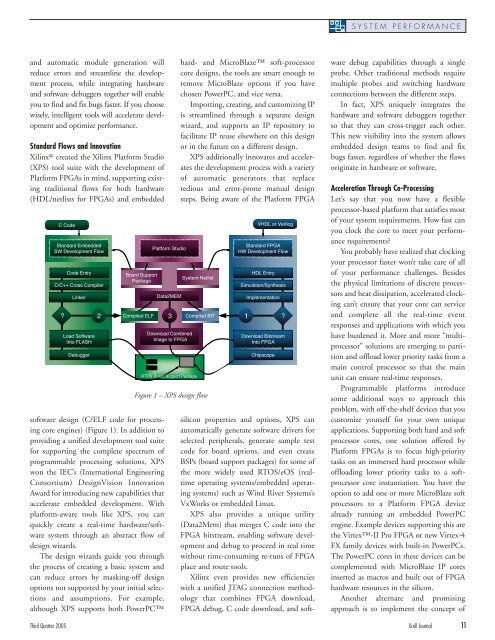Design Challenges: Avoiding the Pitfalls, winning the game - Xilinx
Design Challenges: Avoiding the Pitfalls, winning the game - Xilinx
Design Challenges: Avoiding the Pitfalls, winning the game - Xilinx
Create successful ePaper yourself
Turn your PDF publications into a flip-book with our unique Google optimized e-Paper software.
and automatic module generation will<br />
reduce errors and streamline <strong>the</strong> development<br />
process, while integrating hardware<br />
and software debuggers toge<strong>the</strong>r will enable<br />
you to find and fix bugs faster. If you choose<br />
wisely, intelligent tools will accelerate development<br />
and optimize performance.<br />
Standard Flows and Innovation<br />
<strong>Xilinx</strong> ® created <strong>the</strong> <strong>Xilinx</strong> Platform Studio<br />
(XPS) tool suite with <strong>the</strong> development of<br />
Platform FPGAs in mind, supporting existing<br />
traditional flows for both hardware<br />
(HDL/netlists for FPGAs) and embedded<br />
C Code<br />
Standard Embedded<br />
SW Development Flow<br />
C/C++ Incl ude Cross <strong>the</strong> Compiler BSP<br />
and Compile <strong>the</strong><br />
Softw<br />
Linker<br />
are Image<br />
?<br />
Code Entry<br />
Load Software<br />
Into FLASH<br />
Debugger<br />
Board Support<br />
Package<br />
software design (C/ELF code for processing<br />
core engines) (Figure 1). In addition to<br />
providing a unified development tool suite<br />
for supporting <strong>the</strong> complete spectrum of<br />
programmable processing solutions, XPS<br />
won <strong>the</strong> IEC’s (International Engineering<br />
Consortium) <strong>Design</strong>Vision Innovation<br />
Award for introducing new capabilities that<br />
accelerate embedded development. With<br />
platform-aware tools like XPS, you can<br />
quickly create a real-time hardware/software<br />
system through an abstract flow of<br />
design wizards.<br />
The design wizards guide you through<br />
<strong>the</strong> process of creating a basic system and<br />
can reduce errors by masking-off design<br />
options not supported by your initial selections<br />
and assumptions. For example,<br />
although XPS supports both PowerPC<br />
Platform Studio<br />
Data2MEM<br />
Download Combined<br />
Image to FPGA<br />
hard- and MicroBlaze soft-processor<br />
core designs, <strong>the</strong> tools are smart enough to<br />
remove MicroBlaze options if you have<br />
chosen PowerPC, and vice versa.<br />
Importing, creating, and customizing IP<br />
is streamlined through a separate design<br />
wizard, and supports an IP repository to<br />
facilitate IP reuse elsewhere on this design<br />
or in <strong>the</strong> future on a different design.<br />
XPS additionally innovates and accelerates<br />
<strong>the</strong> development process with a variety<br />
of automatic generators that replace<br />
tedious and error-prone manual design<br />
steps. Being aware of <strong>the</strong> Platform FPGA<br />
System Netlist<br />
2 Compiled ELF 3 Compiled BIT<br />
RTOS Board Support Package<br />
Figure 1 – XPS design flow<br />
VHDL or Verilog<br />
Standard FPGA<br />
HW Development Flow<br />
HDL Entry<br />
Instantiate <strong>the</strong><br />
Simulation/Syn<strong>the</strong>sis<br />
ëSystem Netlistí<br />
and Implement<br />
Implementation<br />
<strong>the</strong> FPGA<br />
1<br />
silicon properties and options, XPS can<br />
automatically generate software drivers for<br />
selected peripherals, generate sample test<br />
code for board options, and even create<br />
BSPs (board support packages) for some of<br />
<strong>the</strong> more widely used RTOS/eOS (realtime<br />
operating systems/embedded operating<br />
systems) such as Wind River Systems’s<br />
VxWorks or embedded Linux.<br />
XPS also provides a unique utility<br />
(Data2Mem) that merges C code into <strong>the</strong><br />
FPGA bitstream, enabling software development<br />
and debug to proceed in real time<br />
without time-consuming re-runs of FPGA<br />
place and route tools.<br />
<strong>Xilinx</strong> even provides new efficiencies<br />
with a unified JTAG connection methodology<br />
that combines FPGA download,<br />
FPGA debug, C code download, and soft-<br />
ware debug capabilities through a single<br />
probe. O<strong>the</strong>r traditional methods require<br />
multiple probes and switching hardware<br />
connections between <strong>the</strong> different steps.<br />
In fact, XPS uniquely integrates <strong>the</strong><br />
hardware and software debuggers toge<strong>the</strong>r<br />
so that <strong>the</strong>y can cross-trigger each o<strong>the</strong>r.<br />
This new visibility into <strong>the</strong> system allows<br />
embedded design teams to find and fix<br />
bugs faster, regardless of whe<strong>the</strong>r <strong>the</strong> flaws<br />
originate in hardware or software.<br />
Acceleration Through Co-Processing<br />
Let’s say that you now have a flexible<br />
processor-based platform that satisfies most<br />
of your system requirements. How fast can<br />
you clock <strong>the</strong> core to meet your performance<br />
requirements?<br />
You probably have realized that clocking<br />
your processor faster won’t take care of all<br />
of your performance challenges. Besides<br />
<strong>the</strong> physical limitations of discrete processors<br />
and heat dissipation, accelerated clocking<br />
can’t ensure that your core can service<br />
and complete all <strong>the</strong> real-time event<br />
responses and applications with which you<br />
have burdened it. More and more “multiprocessor”<br />
solutions are emerging to partition<br />
and offload lower priority tasks from a<br />
main control processor so that <strong>the</strong> main<br />
unit can ensure real-time responses.<br />
Programmable platforms introduce<br />
some additional ways to approach this<br />
problem, with off-<strong>the</strong>-shelf devices that you<br />
customize yourself for your own unique<br />
applications. Supporting both hard and soft<br />
processor cores, one solution offered by<br />
Platform FPGAs is to focus high-priority<br />
tasks on an immersed hard processor while<br />
offloading lower priority tasks to a softprocessor<br />
core instantiation. You have <strong>the</strong><br />
option to add one or more MicroBlaze soft<br />
processors to a Platform FPGA device<br />
already running an embedded PowerPC<br />
engine. Example devices supporting this are<br />
<strong>the</strong> Virtex-II Pro FPGA or new Virtex-4<br />
FX family devices with built-in PowerPCs.<br />
The PowerPC cores in <strong>the</strong>se devices can be<br />
complemented with MicroBlaze IP cores<br />
inserted as macros and built out of FPGA<br />
hardware resources in <strong>the</strong> silicon.<br />
Ano<strong>the</strong>r alternate and promising<br />
approach is to implement <strong>the</strong> concept of<br />
Third Quarter 2005 Xcell Journal 11<br />
?<br />
Download Bitstream<br />
Into FPGA<br />
Chipscope<br />
SYSTEM PERFORMANCE

















